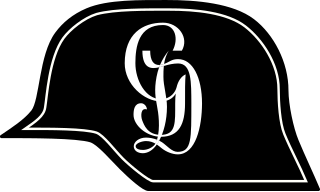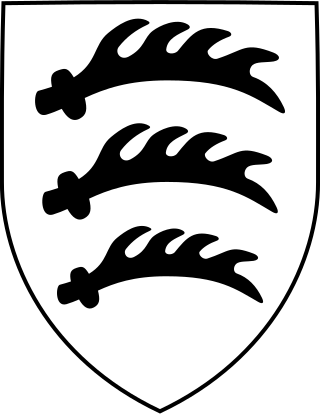
The Waffen-SS was the combat branch of the Nazi Party's paramilitary Schutzstaffel (SS) organisation. Its formations included men from Nazi Germany, along with volunteers and conscripts from both German-occupied Europe and unoccupied lands. It was disbanded in May 1945.

The Panzergrenadier Division "Großdeutschland", also commonly referred to simply as Großdeutschland or Großdeutschland Division, was an elite combat unit of the German Army that fought on the Eastern Front in World War II.

The 11th SS Volunteer Panzergrenadier Division Nordland was a Waffen-SS division primarily raised with Germans and ethnic Germans from Romania, but also foreign volunteers from Western Europe. It saw action, as part of Army Group North, in the Independent State of Croatia and on the Eastern Front during World War II.

The Vistula–Oder offensive was a Red Army operation on the Eastern Front in the European theatre of World War II in January 1945. The army made a major advance into German-held territory, capturing Kraków, Warsaw and Poznań. The Red Army had built up their strength around a number of key bridgeheads, with two fronts commanded by Marshal Georgy Zhukov and Marshal Ivan Konev. Against them, the German Army Group A, led by Colonel-General Josef Harpe, was outnumbered five to one. Within days, German commandants evacuated the concentration camps, sending the prisoners on their death marches to the west, where ethnic Germans also started fleeing. In a little over two weeks, the Red Army had advanced 480 kilometres (300 mi) from the Vistula to the Oder, only 69 kilometres (43 mi) from Berlin, which was undefended. However, Zhukov called a halt, owing to continued German resistance on his northern flank (Pomerania), and the advance on Berlin had to be delayed until April.

The 9th Panzer Division was a panzer division of the German Army during World War II. It came into existence after 4th Light Division was reorganized in January 1940. The division was headquartered in Vienna, in the German military district Wehrkreis XVII.
The III (Germanic) SS Panzer Corps was a Waffen-SS armoured corps which saw action on the Eastern Front during World War II. The (Germanische) part of its designation was granted as it was composed primarily of foreign volunteer formations.

The Battle of Narva was a World War II military campaign, lasting from 2 February to 10 August 1944, in which the German Army Detachment "Narwa" and the Soviet Leningrad Front fought for possession of the strategically important Narva Isthmus.

The Volunteer Legion Netherlands was a collaborationist military formation recruited in the German-occupied Netherlands during World War II. It was formed in the aftermath of the German invasion of the Soviet Union and fought on the Eastern Front in the Waffen SS alongside similar formations from other parts of German-occupied Western Europe. It was the largest Dutch SS unit.
The II SS Panzer Corps was a German Waffen-SS armoured corps which saw action on both the Eastern and Western Fronts during World War II. It was commanded by Paul Hausser during the Third Battle of Kharkov and the Battle of Kursk in 1943 and by Wilhelm Bittrich on the Western Front in 1944.

Panzer-Division Müncheberg was a German panzer division which saw action on the Eastern Front around Berlin during World War II.
The XXXIX Panzer Corps was a German panzer corps which saw action on the Western and Eastern Fronts during World War II.
Army Group Vistula was an Army Group of the Wehrmacht, formed on 24 January 1945. It lasted for 105 days, having been put together from elements of Army Group A, Army Group Centre, and a variety of new or ad hoc formations. It was formed to protect Berlin from the Soviet armies advancing from the Vistula River.

Matthias Kleinheisterkamp was a German SS commander during the Nazi era. Reaching the rank of SS-Obergruppenführer, he commanded the SS Division Totenkopf, SS Division Nord, SS Division Das Reich, III SS Panzer Corps, VII SS Panzer Corps, IV SS Panzer Corps, XII SS Army Corps and the XI SS Army Corps in World War II. Kleinheisterkamp died by suicide after being captured by the Soviets.
The defense of the Schwedt bridgehead was a German 3rd Panzer Army operation on the Eastern Front during the final months of World War II. German forces, commanded by Otto Skorzeny, were ordered to prepare to conduct a counter-offensive. However they were forced to hold a bridgehead against expected numerically superior forces of the Soviet 2nd Belorussian Front for 31 days. Their position was largely ignored during the Red Army's Cottbus–Potsdam Offensive Operation which breached German defenses at Gartz to the north of Schwedt. This was unexpected because it required the Red Army to cross the Randowbruch Swamp that lay between the Oder and Randow rivers.

The 11th SS Panzer Army was little more than a paper army formed in February 1945 by Heinrich Himmler while he was commander of Army Group Vistula.
The 19th Panzer Division was an armoured division in the German Army, the Wehrmacht, during World War II. It was created from the 19th Infantry Division.
Operation Solstice, also known as Unternehmen Husarenritt or the Stargard tank battle, was one of the last German armoured offensive operations on the Eastern Front in World War II.

The Upper Silesian offensive was a strategically significant Soviet offensive on the Eastern Front of World War II in 1945. It was aimed at capturing the considerable industrial and natural resources located in Upper Silesia and involved forces of the 1st Ukrainian Front under Marshal Ivan Konev. Due to the importance of the region to the Germans, considerable forces were provided to Army Group Centre for its defence and the Germans were only slowly pushed back to the Czech border. Fighting for the region lasted from mid January right until the last day of the war in Europe on May 8, 1945.

The 25th Infantry Division was a military unit of the German Wehrmacht. It was later reclassified to 25th Motorized Infantry Division, and in June 1943 to the 25th Panzergrenadier Division.

The 712th Infantry Division was a German Army Infantry division in World War II.












